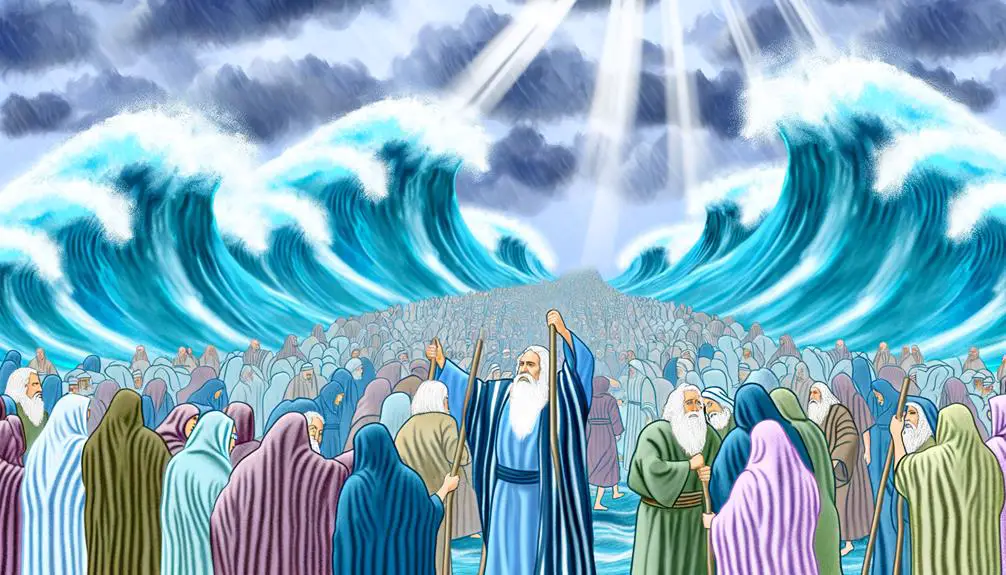Learn how epic narratives in the Bible unveil profound divine-human interactions, and discover…

Epics in the Bible
In exploring epics within the Bible, you're engaging with narratives that encapsulate divine interaction with humanity through complex spiritual journeys. Each story, whether it's the methodical creation in Genesis, Moses' strategic liberation of the Israelites in Exodus, or the poetic and prophetic declarations in Isaiah, reveals intricate patterns of divine intention and human response. These accounts aren't just historical records; they are theological expositions deeply woven with symbolic meaning and ethical concerns, exploring themes from power dynamics to personal perseverance in faith. The further you explore these texts, the more insights unfold about the intertwining of divine and mortal domains.
Key Takeaways
- The Creation Story in Genesis depicts a divine plan of the universe, symbolizing order with humanity as stewards.
- Exodus highlights Moses' leadership and the Israelites' journey to freedom, emphasizing divine-human collaboration.
- The rise of King David showcases his political skills and divine favor through critical events like defeating Goliath.
- Job's narrative explores themes of faith and righteousness amidst intense personal suffering and divine testing.
- The Book of Revelation provides symbolic and apocalyptic visions predicting divine judgment and the ultimate salvation of humanity.
The Creation Story in Genesis

In Genesis, the Creation story unfolds through a detailed, seven-day process, illustrating a methodical divine plan that sets the foundation for all existence. As you explore further into the narrative, you encounter the Garden of Eden, brimming with profound symbolism. This garden isn't just a paradise of ease and abundance; it represents a divine order and harmony, a microcosm of the ideal relationship between humanity and the divine. The trees, rivers, and the very act of naming the animals signify humanity's role within this sacred space—stewards rather than mere inhabitants.
The Serpent's role introduces a pivotal dynamic to this environment. Traditionally viewed as a malevolent disruptor, the Serpent in Eden challenges the perfection of the Garden by tempting Eve. This act isn't just a simple narrative twist but a complex symbol of wisdom, temptation, and the dual nature of knowledge—its power to both enlighten and corrupt. By engaging with the Serpent, humanity's eyes are opened to the broader spectrum of moral and existential realities, marking the shift from a state of innocent obedience to one of informed, albeit painful, awareness. This shift underscores a critical theme in Genesis: the painful growth that comes from self-awareness and moral understanding.
The Exodus and Moses
You'll find that Moses' leadership journey, as chronicled in the Exodus story, serves as a seminal example of divine human partnership in biblical narratives. His strategic navigation through the plagues of Egypt highlights a complex interplay between divine intervention and human agency. This analysis contributes to understanding how these events shape the Israelites' collective identity and their perception of power and morality.
Moses' Leadership Journey
Moses' leadership journey, marked by trials and triumphs, serves as a profound example of transformational leadership throughout the Exodus narrative. During the desert wanderings, you witness his evolution from a reluctant speaker to a formidable leader. His leadership qualities—perseverance, faith, and decisiveness—are prominently displayed as he navigates the challenges of guiding a fractious community through inhospitable terrain. This period is critical in understanding how his strategies adapt under continuous pressure, including managing scarce resources and addressing internal conflicts. His ability to maintain his vision and uphold his moral convictions, despite the overwhelming odds, underscores the complexity of his role. Moses' journey not only defines a pivotal era in biblical history but also offers timeless lessons in leadership resilience and adaptability.
Plagues of Egypt
As we examine the Plagues of Egypt, it becomes evident that these calamities not only tested the resilience of Moses but also demonstrated the dramatic power dynamics at play between the Hebrews and the Egyptians. The first plague, the transformation of the Nile into blood, serves as a profound symbol of life turned into a source of death, disrupting the ecological and spiritual heart of Egypt. This event precipitated severe agricultural impacts, as the contaminated waters devastated crop yields and livestock sustainability. Each subsequent plague further dismantled the economic stability and social structure of Egyptian society, strategically weakening Pharaoh's hold over the Hebrews. This narrative arc underscores the tactical use of natural disasters to recalibrate power structures and liberate an oppressed people.
The Rise of King David

King David's ascent to power is a multifaceted narrative that reflects both his profound faith and adept political maneuvering. In your exploration of this biblical epic, you'll see how David's harp, often symbolizing his divine favor, played a pivotal role in his rise. This instrument not only soothed King Saul's troubled spirit but also established David as a figure of peace and spirituality in the royal court. Additionally, David's defeat of Goliath wasn't just a victory over a giant; it was a critical political event that catapulted him into the national spotlight and solidified his status as a military leader and eventual king.
As you uncover deeper layers, you'll notice that David's journey to kingship was intricately woven with personal challenges and public triumphs. His strategic alliances, such as his covenant with Jonathan and his marriage to Michal, Saul's daughter, were essential for his integration into the royal family and the national leadership structure. Furthermore, his time in the wilderness, evading King Saul's attempts on his life, not only tested his resilience but also strengthened his claim to divine protection and legitimacy. Through these actions, David didn't just navigate his path to the throne; he shaped the very fabric of Israelite society.
The Trials of Job
As you explore the trials of Job, it's essential to ponder how his unwavering faith is depicted amidst severe divine tests. This narrative not only challenges your understanding of faith and righteousness but also provides a profound insight into the nature of suffering and divine justice. Analyzing these elements reveals the complexities of Job's character and the broader theological implications within the text.
Job's Enduring Faith
Job's enduring faith, despite overwhelming trials, exemplifies a profound spiritual resilience that challenges and inspires believers to contemplate the depths of their own faith. Analyzing Job's resilience, you might recognize that his unyielding adherence to his faith, even amidst devastating losses and physical suffering, is not merely a personal victory but also a theological cornerstone. It offers a lens through which to view suffering's purpose—not as divine retribution but as a medium for spiritual fortification and enlightenment. Job's story prompts you to question the nature of your trials and the strength of your faith under pressure. His narrative serves as a reflective mirror, urging a deeper exploration of the interplay between human suffering and divine wisdom.
Divine Tests Explained
Building on Job's unyielding faith, it's important to understand the divine rationale behind the harrowing tests he endured. Like Abraham's obedience and the construction of Noah's ark, Job's trials aren't merely punitive but are deeply instructive and symbolic. They serve to refine his piety and resilience, much as fire refines gold. You'll notice that, through these trials, Job's understanding of divine sovereignty and human suffering is profoundly deepened. His perseverance transforms him into a paradigm of unwavering faith in the face of inexplicable adversity. This narrative arc aims to teach you that true faith is not about unchallenged tranquility but about steadfastness amidst severe trials. Job's story, hence, isn't just about suffering; it's a theological exploration of righteous perseverance under trial.
The Prophecies of Isaiah

The prophecies of Isaiah, a pivotal figure in biblical literature, reveal profound insights into the socio-political upheavals and spiritual dimensions of his time. You'll find that Isaiah's authorship, particularly in the context of the first 39 chapters, is traditionally unified, though modern scholarship suggests multiple authors contributing over several centuries. This perspective enriches your understanding of the text's complexity and the layered responses to the periods of crisis and reform in ancient Judah.
Isaiah's Servant Songs (Isaiah 42:1-4, 49:1-6, 50:4-9, 52:13-53:12) stand out as a distinct and vital element within these prophecies. They introduce a figure known as the 'Servant of the Lord,' whose role is deeply interpretative and has been subject to various scholarly debates. You'll notice that these songs blend poetic intensity with theological depth, exploring themes of suffering, redemption, and the servant's mission among the nations. The identity of the Servant—whether an individual or a collective—has been a focal point of discussion, reflecting broader theological implications for understanding covenantal relationships, divine justice, and redemption in Isaiah's prophecies.
Analyzing these elements, you're engaging with a text that not only reflects its own time but also resonates through the ages, influencing countless religious and philosophical thoughts.
The Life and Teachings of Jesus
Exploring Jesus' life and teachings reveals a profound transformation of religious thought and practice, deeply rooted in the historical and cultural contexts of first-century Judea. You'll find that his approach was revolutionary, intertwining miraculous healings with parable teachings to communicate his messages. The miraculous healings weren't just demonstrations of divine power but were also deeply symbolic acts. Each healing you examine, from restoring sight to the blind to curing leprosy, underscored themes of purification, restoration, and the breaking of societal boundaries. These acts challenged the prevailing notions of impurity and exclusion prevalent in Jewish law at the time.
In tandem with these physical healings, Jesus' use of parables—a form of teaching through simple, relatable stories—allowed him to convey complex theological and ethical teachings in a manner that was accessible to the diverse and often uneducated population of that era. The parables functioned as both a method of instruction and a tool for revelation, inviting you, the listener, to unravel deeper layers of meaning. For instance, the Parable of the Good Samaritan isn't just a call to help others but a radical redefinition of 'neighbor' that crosses ethnic and religious lines, promoting a broader, inclusive form of community solidarity.
These intertwined methods of miraculous healings and parables were central to Jesus' mission, reshaping religious perspectives and encouraging a more inclusive and compassionate worldview.
The Visions of Revelation

While the life and teachings of Jesus provided a foundation for understanding divine interaction with humanity, the Visions of Revelation offer a complex and symbolic portrayal of the culmination of divine plans for the world. As you explore this final book of the New Scriptures, you'll encounter a vivid tableau of apocalyptic symbols, each meticulously designed to convey profound theological truths and future predictions.
Revelation's imagery, from the Four Horsemen to the beast rising from the sea, challenges you to interpret layers of symbolism that intertwine divine judgment and salvation. These symbols aren't just for dramatic effect; they serve as a coded language through which divine messages about the end times are communicated. For instance, the beast symbolizes oppressive empires that rise and fall, illustrating the transient nature of earthly powers in comparison to the eternal sovereignty of God.
Moreover, the recurring theme of the number seven—seen in the seals, trumpets, and bowls—emphasizes completeness and perfection in God's plan. This numeric symbolism isn't arbitrary; it's a carefully chosen representation of divine completeness, mirroring the creation week and suggesting a re-creation or restoration of the world.
In understanding these visions, you're invited to reflect on the transient nature of human affairs and the ultimate triumph of divine will, offering a perspective that transcends temporal struggles.
Frequently Asked Questions
How Do Biblical Epics Influence Modern Literature and Film?
You'll find that modern literature and film often draw on character archetypes and narrative patterns that, while prevalent in many traditional stories, are particularly resonant and well-defined in historical and mythical epics.
What Are the Key Moral Lessons in Biblical Epics?
In exploring timeless narratives, you'll find that key moral lessons often revolve around divine justice and heroic faithfulness, underscoring the virtues of integrity and perseverance in the face of overwhelming challenges.
How Do Biblical Epics Reflect the Culture of Their Times?
Biblical epics mirror their era's societal norms and historical accuracy, showing you how narratives were shaped by the prevailing values and historical context, deepening your understanding of ancient cultural and religious landscapes.
Are There Common Themes Across Different Biblical Epics?
Yes, you'll find that divine intervention and heroic journeys are common themes in many narratives, reflecting universal struggles between good and evil, trials, and triumphs that resonate deeply on both personal and collective levels.
How Have Interpretations of Biblical Epics Changed Over Time?
As time marches on, interpretations of ancient texts evolve, shaped by shifting historical contexts and interpretive frameworks. You'll find that scholars continuously reassess narratives, deepening our understanding of their complexity and relevance.



Sign up